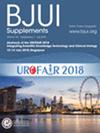The role of PSMA PET/CT in staging patients with intermediate-risk prostate cancer.
IF 4.4
2区 医学
Q1 UROLOGY & NEPHROLOGY
引用次数: 0
Abstract
OBJECTIVE To synthesise data evaluating the diagnostic utility of prostate-specific membrane antigen (PSMA) positron emission tomography/computed tomography (PET/CT) in intermediate-risk prostate cancer (PCa), as its role in intermediate-risk PCa remains uncertain. METHODS A systematic search was conducted for studies evaluating PSMA PET/CT in primary staging of newly diagnosed European Association of Urology (EAU)/National Comprehensive Cancer Network (NCCN) intermediate-risk, or Gleason Score 7 (International Society of Urological Pathology [ISUP] Grade Group [GG] 2-3) PCa. The primary outcome was overall positive scans (lymph nodes or distant metastases). We also secondarily analysed diagnostic accuracy measuring sensitivity, specificity, positive predictive value, and negative predictive value. RESULTS In total, 16 studies reported positivity rates ranging from 2.2% to 50.0% in intermediate-risk PCa. A pooled analysis of 13 studies found a PSMA PET/CT positivity rate of 9% (95% confidence interval [CI] 6-11%). In ISUP GG 2 PCa, positivity ranged from 2.2% to 21.4%, compared to 13.6-33.3% in ISUP GG 3 PCa (across two studies). The overall nodal and metastatic sensitivity of PSMA PET/CT was low in intermediate-risk men, 33% (95% CI 14-60%). Limitations included small sample sizes, retrospective designs, and limited histopathological confirmation. CONCLUSION For primary staging in intermediate-risk PCa PSMA PET/CT showed a low yield. Limited data exist to guide its use in favourable vs unfavourable subgroups. Robust, prospective studies are needed to define its role in clinical decision-making, further prognostic benefits, and to inform future guidelines.PSMA PET/CT在中危前列腺癌分期中的作用
目的综合评估前列腺特异性膜抗原(PSMA)正电子发射断层扫描/计算机断层扫描(PET/CT)在中危前列腺癌(PCa)诊断中的应用价值,因为其在中危前列腺癌中的作用尚不确定。方法系统检索评估PSMA PET/CT在新诊断的欧洲泌尿外科协会(EAU)/国家综合癌症网络(NCCN)中度风险或Gleason评分7(国际泌尿外科病理学会[ISUP]分级组[GG] 2-3)前列腺癌初级分期的研究。主要结果为总体阳性扫描(淋巴结或远处转移)。我们还分析了诊断的准确性,测量敏感性、特异性、阳性预测值和阴性预测值。结果共16项研究报告中危PCa阳性率为2.2% ~ 50.0%。13项研究的汇总分析发现PSMA PET/CT阳性率为9%(95%置信区间[CI] 6-11%)。在两项研究中,ISUP GG 2 PCa的阳性范围为2.2%至21.4%,而ISUP GG 3 PCa的阳性范围为13.6-33.3%。PSMA PET/CT的总体淋巴结和转移敏感性在中危男性中较低,为33% (95% CI 14-60%)。局限性包括样本量小、回顾性设计和有限的组织病理学证实。结论PSMA PET/CT对原发性中危性前列腺癌的检出率较低。现有的数据有限,无法指导其在有利和不利亚群中的使用。需要强有力的前瞻性研究来确定其在临床决策中的作用,进一步的预后益处,并为未来的指导方针提供信息。
本文章由计算机程序翻译,如有差异,请以英文原文为准。
求助全文
约1分钟内获得全文
求助全文
来源期刊

BJU International
医学-泌尿学与肾脏学
CiteScore
9.10
自引率
4.40%
发文量
262
审稿时长
1 months
期刊介绍:
BJUI is one of the most highly respected medical journals in the world, with a truly international range of published papers and appeal. Every issue gives invaluable practical information in the form of original articles, reviews, comments, surgical education articles, and translational science articles in the field of urology. BJUI employs topical sections, and is in full colour, making it easier to browse or search for something specific.
 求助内容:
求助内容: 应助结果提醒方式:
应助结果提醒方式:


